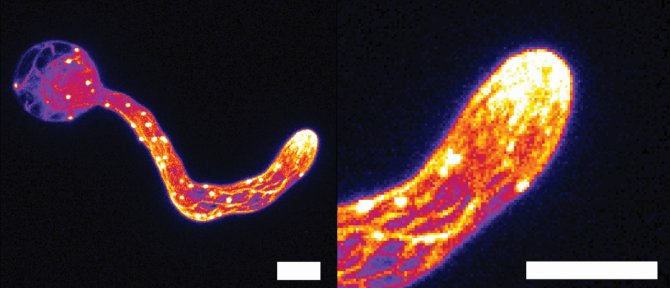
News
Wageningen scientists unravel how the potato disease sharpens its weapons
Last year, a team of researchers at Wageningen University & Research discovered how the cells of Phytophthora infestans (potato blight disease) attacks the plant by slicing open its skin. But how these microscopic attackers sharpen their weapons was unknown. This mystery has now been solved. The findings of the multidisciplinary research team have been presented in the journal Science Advances.
Phytophthora is a group of microorganisms that cause devastating diseases in plants across a variety of crops, such as tomato, potato, peppers and cacao. The most notorious member of the family is Phytophthora infestans, responsible for causing the potato blight disease, as mentioned. The potato pathogen hitchhikes on water droplets during rainfall, and when it lands on the leaf, an ingenious mechanism is activated.
The single-celled water mold contains an internal skeleton in the tubular structure it wields as its weapon of attack. The scientists discovered that this cell skeleton, formed from threadlike proteins, in no-time – within 10 seconds – detects the contact with the plant and senses how strong the plant pushes back. Using this information, the cell regroups its proteins to form a ninja-like blade with a sharp point, which it uses to cut open the leaf.
Self-sharpening knife
As if that isn’t peculiar enough, this same mechanism, which the researchers call a mechanostat, also makes sure that the tip of the tubular weapon remains sharp throughout the infection process, like a self-sharpening knife. Since the weapon is made from the same materials as the plant, without this trick, it would quickly become blunt and unable to cut. By forming increasingly strong threads of proteins at the tip of the tube, the mechanostat takes care that the blade remains sharp during the cutting process. How sharp it needs to be, is decided by the mechanostat based on the pressure it detects.

A multidiscplinary team, headed by professor Joris Sprakel of the Laboratory of Biochemistry, together with dr. Tijs Ketelaar and prof. Francine Govers, uncovered this fascinating process. Sprakel: 'This is a beautiful example of the elegance by which nature controls mechanical processes. Of course, these micro-organisms do not have a nervous system by which they can perceive touch. The sense of touch must thus be programmed in the molecules that form the cell skeleton'.
The cell’s sense of touch must be programmed in the molecules that form the cytoskeleton
New forms of control
Now that it is clear how Phytophthora begins its infectious lifestyle in the plant, we can work towards new form of pest control. The scientists think they know which protein makes the mechanical warfare of these pathogens possible. Sprakel: “The most interesting aspect of this, is that this protein is found in the pathogens but not in plants. This makes it an ideal target for control strategies”. A new project to study will start soon.